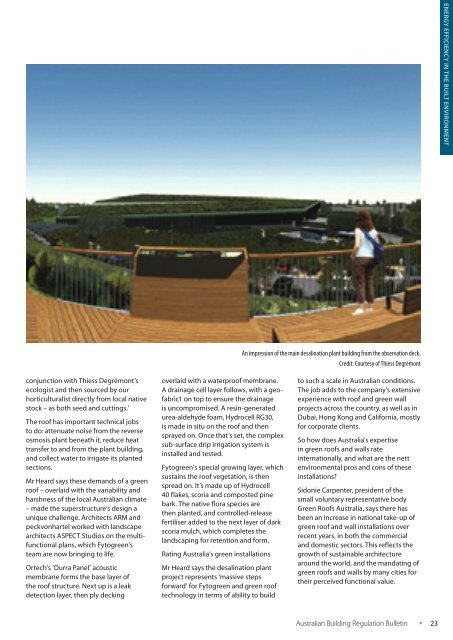PDF | 9 MB - Australian Building Codes Board
PDF | 9 MB - Australian Building Codes Board
PDF | 9 MB - Australian Building Codes Board
Create successful ePaper yourself
Turn your PDF publications into a flip-book with our unique Google optimized e-Paper software.
ENERGY EFFICIENCY NCC + IN iNDUSTRY THE BUILT NEWS ENVIRONMENT<br />
An impression of the main desalination plant building from the observation deck.<br />
Credit: Courtesy of Thiess Degrémont<br />
conjunction with Thiess Degrémont’s<br />
ecologist and then sourced by our<br />
horticulturalist directly from local native<br />
stock – as both seed and cuttings.’<br />
The roof has important technical jobs<br />
to do: attenuate noise from the reverse<br />
osmosis plant beneath it, reduce heat<br />
transfer to and from the plant building,<br />
and collect water to irrigate its planted<br />
sections.<br />
Mr Heard says these demands of a green<br />
roof – overlaid with the variability and<br />
harshness of the local <strong>Australian</strong> climate<br />
– made the superstructure’s design a<br />
unique challenge. Architects ARM and<br />
peckvonhartel worked with landscape<br />
architects ASPECT Studios on the multifunctional<br />
plans, which Fytogreen’s<br />
team are now bringing to life.<br />
Ortech’s ‘Durra Panel’ acoustic<br />
membrane forms the base layer of<br />
the roof structure. Next up is a leak<br />
detection layer, then ply decking<br />
overlaid with a waterproof membrane.<br />
A drainage cell layer follows, with a geofabric1<br />
on top to ensure the drainage<br />
is uncompromised. A resin-generated<br />
urea-aldehyde foam, Hydrocell RG30,<br />
is made in situ on the roof and then<br />
sprayed on. Once that’s set, the complex<br />
sub-surface drip irrigation system is<br />
installed and tested.<br />
Fytogreen’s special growing layer, which<br />
sustains the roof vegetation, is then<br />
spread on. It’s made up of Hydrocell<br />
40 flakes, scoria and composted pine<br />
bark. The native flora species are<br />
then planted, and controlled-release<br />
fertiliser added to the next layer of dark<br />
scoria mulch, which completes the<br />
landscaping for retention and form.<br />
Rating Australia’s green installations<br />
Mr Heard says the desalination plant<br />
project represents ‘massive steps<br />
forward’ for Fytogreen and green roof<br />
technology in terms of ability to build<br />
to such a scale in <strong>Australian</strong> conditions.<br />
The job adds to the company’s extensive<br />
experience with roof and green wall<br />
projects across the country, as well as in<br />
Dubai, Hong Kong and California, mostly<br />
for corporate clients.<br />
So how does Australia’s expertise<br />
in green roofs and walls rate<br />
internationally, and what are the nett<br />
environmental pros and cons of these<br />
installations?<br />
Sidonie Carpenter, president of the<br />
small voluntary representative body<br />
Green Roofs Australia, says there has<br />
been an increase in national take-up of<br />
green roof and wall installations over<br />
recent years, in both the commercial<br />
and domestic sectors. This reflects the<br />
growth of sustainable architecture<br />
around the world, and the mandating of<br />
green roofs and walls by many cities for<br />
their perceived functional value.<br />
<strong>Australian</strong> <strong>Building</strong> Regulation Bulletin<br />
• 23
















